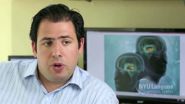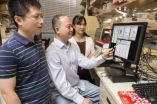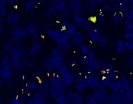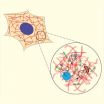Computation and collaboration lead to significant advance in malaria
2014-08-14
(Press-News.org) HOUSTON – (August 14, 2014) -- Researchers led by Baylor College of Medicine have developed a new computational method to study the function of disease-causing genes, starting with an important new discovery about a gene associated with malaria – one of the biggest global health burdens.
The work published today in the current issue of the journal Cell includes collaborators comprised of computational and evolutionary biologists and leading malaria experts from Baylor, Columbia University Medical Center, Princeton University, Pennsylvania State University and the National Institute of Allergy and Infectious Diseases (NIAID).
"Today, rapidly falling costs means that high throughput sequencing projects are revealing the entire gene sequences of ever more species, but the biological functions of most of these genes remain unknown,” said Dr. Olivier Lichtarge, professor of molecular and human genetics and director of the Computational and Integrative Biomedical Research Center at Baylor and senior author of the report. “To address this problem, our lab has developed new methods to predict gene and protein functions."
Dr. Andreas Martin Lisewski, an instructor in Lichtarge’s lab at Baylor, served as the leading author on the report.
The researchers came up with a computational method that allows biological information to literally flow from gene to gene across a massive network across many genomes, known as the "supergenomic" network.
"The network connects millions of genes from hundreds of species based on their interactions within the organism or based on their ancestral relations between different species," said Lisewski. "Normally, computing the flow of functional information would be costly and slow, but we developed a compression method that reduces this gigantic network into one that is much smaller and now computationally tractable. The surprise is that these biological networks are compressible much like digital data in today’s computers."
To test their method, the researchers looked at functional predictions of a protozoan parasite known to cause the most severe form of malaria in humans – Plasmodium falciparum. While it has been more than 10 years since the genome of this parasite was fully sequenced, still too little is known about the function for most of its genes.
Every year, malaria affects more than 200 million people and contributes to nearly 1 million deaths worldwide.
"To better understand this disease, we need to identify more functions of the parasite’s genes. This understanding may eventually help us to stem the rise of drug-resistant malaria, such as the emerging resistance to artemisinins," said Lisewski.
Artemisinins are a family of drugs that currently form the frontline treatment against
Plasmodium falciparum malaria. Artemisinin was originally isolated as an extract from a traditional Chinese herbal remedy, and while it is still highly effective against malaria in patients, the mechanism of action has been unclear. A loss of artemisinin’s antimalarial effectiveness due to genetic resistance would have devastating global health consequences.
The researchers honed in on the parasite protein EXP1 that was known to be essential to the malaria parasite but for which there were no details on its function.
Using the network, they showed that this protein enables the parasite to detoxify the main metabolic byproducts it creates in red blood cells. They also demonstrated that it has a direct role in drug action and susceptibility to artesunate, an important member of the artemisinin drug family.
"Through this multi-year collaborative effort, we now have an improved understanding of the protective molecular mechanisms of the malaria parasite and its drug susceptibility to artesunate. As we are witnessing a rise of resistance to artemisinins, these results may help finding new pathways to successor drugs," said Lichtarge.
INFORMATION:
Other co-authors include Joel Quiros, Anbu Karani Adikesavan, Nagireddy Putluri, Sam Regenbogen, and Arun Sreekumar, all of Baylor; David Fidock, Caroline Ng, Richard Eastman and Daniel Scanfeld of Columbia University; Carole Long and Kazutoyo Miura of the NIAID; Lindsey Altenhofen and Manuel Llinás of Princeton University and Pennsylvania State.
Funding for this work was provided by the National Institutes of Health (GM066099, GM079656 to Lichtarge; AI079709 to Fidock); the National Science Foundation (CCF-0905536, DBI-0851393 to Lichtarge; Alkek Center for Molecular Discovery funding support for Putluri and Sreekumar; Divisions of Intramural Research at the National Institute of Allergy and Infectious Diseases, National Institutes of Health funding to Miura, Eastman and Long; Burroughs Wellcome Fund Investigators in Pathogenesis of Infectious Disease Grant and an NIH Director’s New Innovators award (1DP2OD001315-01) with generous support from the Centre for Quantitative Biology (P50 GM071508) to Llinás. END
ELSE PRESS RELEASES FROM THIS DATE:
Researchers identify a brain 'switchboard' important in attention and sleep
2014-08-14
VIDEO:
Michael Halassa, M.D., Ph.D. discusses his work with the thalamic reticular nucleus (TRN) and it's importance in identifying new targets for treating various psychiatric disorders like schizophrenia, autism and post-traumatic...
Click here for more information.
New York City, August 14, 2014 - Researchers at NYU Langone Medical Center and elsewhere, using a mouse model, have recorded the activity of individual nerve cells in a small part of the brain that works as a "switchboard," ...
Genetic signal prevents immune cells from turning against the body
2014-08-14
LA JOLLA—When faced with pathogens, the immune system summons a swarm of cells made up of soldiers and peacekeepers. The peacekeeping cells tell the soldier cells to halt fighting when invaders are cleared. Without this cease-fire signal, the soldiers, known as killer T cells, continue their frenzied attack and turn on the body, causing inflammation and autoimmune disorders such as allergies, asthma, rheumatoid arthritis, multiple sclerosis and type 1 diabetes.
Now, scientists at the Salk Institute have discovered a key control mechanism on the peacekeeping cells that ...
Common mutation successfully targeted in Lou Gehrig's disease and frontotemporal dementia
2014-08-14
JUPITER, FL, August 14, 2014 – An international team led by scientists from the Florida campuses of The Scripps Research Institute (TSRI) and the Mayo Clinic have for the first time successfully designed a therapeutic strategy targeting a specific genetic mutation that causes a common form of amyotrophic lateral sclerosis (ALS), better known as Lou Gehrig's disease, as well a type of frontotemporal dementia (FTD).
The scientists developed small-molecule drug candidates and showed they interfere with the synthesis of an abnormal protein that plays a key role in causing ...
Scientists use lasers to control mouse brain switchboard
2014-08-14
VIDEO:
Scientists studied how just a few nerve cell in the mouse brain may control the switch between internal thoughts and external distractions. Using optogenetics, a technique that uses light-sensitive molecules...
Click here for more information.
Ever wonder why it's hard to focus after a bad night's sleep? Using mice and flashes of light, scientists show that just a few nerve cells in the brain may control the switch between internal thoughts and external distractions. The ...
Long antibiotic treatments: Slowly growing bacteria to blame
2014-08-14
Whether pneumonia or sepsis – infectious diseases are becoming increasingly difficult to treat. One reason for this is the growing antibiotic resistance. But even non-resistant bacteria can survive antibiotics for some time, and that's why treatments need to be continued for several days or weeks. Scientists at the Biozentrum of the University of Basel showed that bacteria with vastly different antibiotic sensitivity coexist within the same tissue. In the scientific journal Cell they report that, in particular, slowly growing pathogens hamper treatment.
Many bacteria ...
Tissue development 'roadmap' created to guide stem cell medicine
2014-08-14
In a boon to stem cell research and regenerative medicine, scientists at Boston Children's Hospital, the Wyss Institute for Biologically Inspired Engineering at Harvard University and Boston University have created a computer algorithm called CellNet as a "roadmap" for cell and tissue engineering, to ensure that cells engineered in the lab have the same favorable properties as cells in our own bodies. CellNet and its application to stem cell engineering are described in two back-to-back papers in the August 14 issue of the journal Cell.
Scientists around the world are ...
Antibodies, together with viral 'inducers,' found to control HIV in mice
2014-08-14
Although HIV can now be effectively suppressed using anti-retroviral drugs, it still comes surging back the moment the flow of drugs is stopped. Latent reservoirs of HIV-infected cells, invisible to the body's immune system and unreachable by pharmaceuticals, ensure that the infection will rebound after therapy is terminated.
But a new strategy devised by researchers at Rockefeller University harnesses the power of broadly neutralizing antibodies against HIV, along with a combination of compounds that induce viral transcription, in order to attack these latent reservoirs ...
Researchers identify a mechanism that stops progression of abnormal cells into cancer
2014-08-14
(Boston)-- Researchers from Boston University School of Medicine (BUSM) report that a tumor suppressor pathway, called the Hippo pathway, is responsible for sensing abnormal chromosome numbers in cells and triggering cell cycle arrest, thus preventing progression into cancer.
Although the link between abnormal cells and tumor suppressor pathways—like that mediated by the well known p53 gene—has been firmly established, the critical steps in between are not well understood. According to the authors, whose work appears in Cell, this work completes at least one of the ...
Researchers develop strategy to combat genetic ALS, FTD
2014-08-14
JACKSONVILLE, Fla. — A team of researchers at Mayo Clinic and The Scripps Research Institute in Florida have developed a new therapeutic strategy to combat the most common genetic risk factor for the neurodegenerative disorders amyotrophic lateral sclerosis (ALS or Lou Gehrig's disease) and frontotemporal dementia (FTD). In the Aug. 14 issue of Neuron, they also report discovery of a potential biomarker to track disease progression and the efficacy of therapies.
The scientists developed a small-molecule drug compound to prevent abnormal cellular processes caused by a ...
Inside the cell, an ocean of buffeting waves
2014-08-14
Cambridge, Mass. – August 14, 2014 – Conventional wisdom holds that the cytoplasm of mammalian cells is a viscous fluid, with organelles and proteins suspended within it, jiggling against one another and drifting at random. However, a new biophysical study led by researchers at Harvard University challenges this model and reveals that those drifting objects are subject to a very different type of environment.
The cytoplasm is actually an elastic gel, it turns out, so it puts up some resistance to simple diffusion. But energetic processes elsewhere in the cell—in the cytoskeleton, ...





